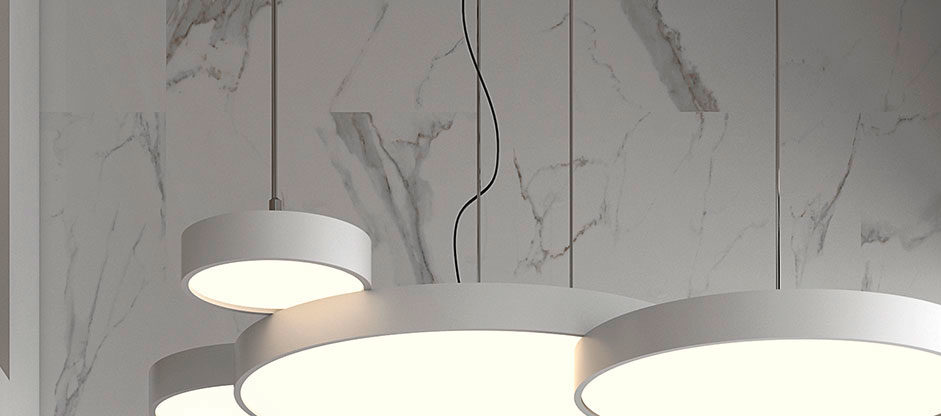The bathroom has evolved from a purely functional space into a haven of design and personal well-being. The trends for 2025 reinforce this transformation, placing emphasis on sustainable materials, sophisticated architectural compositions and a clear focus on sensory comfort.
This year, the bathroom becomes a contemporary oasis where ceramics, technology and emotional design come together.
Below, we explore the key trends set to shape bathroom design in 2025.
1. Seamless, continuous surfaces
Large-format ceramics with no visible joints take centre stage across floors, walls and even integrated washbasins and furniture. These surfaces not only offer a clean, minimalist aesthetic but also improve hygiene by reducing areas where moisture can accumulate.
Finishes that emulate natural stone, microcement or mineral textures in earthy tones will remain at the forefront. The aim is to create a soothing, immersive atmosphere that exudes harmony.
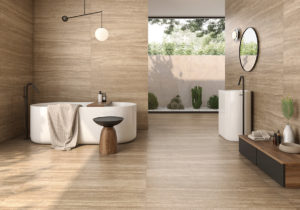
2. Spa-inspired bathrooms: multisensory well-being
In 2025, bathrooms draw inspiration from spa environments, delivering a fully immersive sensory experience. Features such as rainfall showers, ergonomic free-standing bathtubs, dimmable ambient lighting and built-in aromatherapy are becoming increasingly common.
These elements are complemented by warm, enveloping materials such as treated woods, textile-effect ceramics and natural stone, creating spaces that invite calm and disconnection.
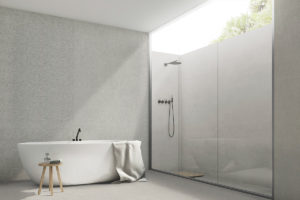
3. Natural, sophisticated colour palettes
Bathroom colour schemes are becoming more nuanced and refined. Neutral, warm and earthy shades – like sand, beige, taupe and terracotta – will define the palettes of 2025. We’ll also see mossy greens, warm greys and touches of matte black providing depth and contrast.
This trend reflects a growing desire to reconnect with nature and create timeless, sanctuary-like spaces.
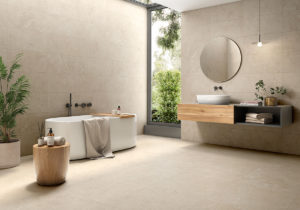
4. Textured ceramics and artisanal reliefs
The growing interest in tactile design is reflected in the rising popularity of ceramic surfaces with textured reliefs – from subtle geometric patterns to zellige-style finishes and handcrafted pieces. These materials bring visual dynamism and sensory richness, making them ideal for both residential bathrooms and contract projects looking to inject personality.
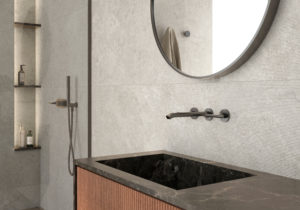
5. Integrated, unobtrusive technology
Technological innovation continues to advance – becoming increasingly discreet and refined. Smart toilets, touch-control mirrors, automated lighting and sensor-activated taps are subtly integrated, preserving the visual harmony of the space.
This is technology focused on comfort, sustainability and energy efficiency – ideal for high-traffic public areas or cutting-edge, design-led homes.
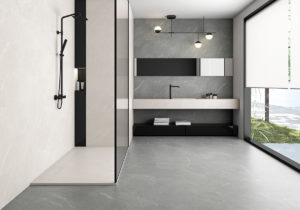
6. Mirrors and lighting as key design elements
In 2025, mirrors will go beyond mere functionality to become decorative features that open up the space and reflect light. Expect compositions with curved silhouettes, perimeter LED lighting and frames in warm metallic finishes.
Lighting, too, will strike a balance between functionality and emotion: recessed fixtures, directional spotlights and suspended lamps will create layers of light that adapt to the time of day and desired ambience.
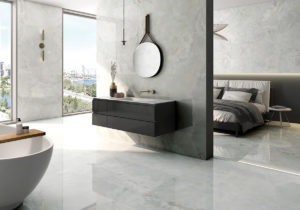
ITT Ceramic: the perfect union of innovation and well-being in the bathroom of the future
In 2025, the bathroom will establish itself as one of the most strategic spaces in interior design. A space where technical innovation and aesthetic value come together to deliver solutions that not only meet today’s needs but also anticipate tomorrow’s expectations. Ceramics – with their adaptability and distinct identity – will continue to be the leading material for transforming bathrooms into true sanctuaries of design and well-being.
